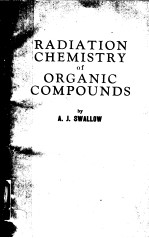

RADIATION CHEMISTRY OF ORGANIC COMPOUNDSPDF电子书下载
- 电子书积分:13 积分如何计算积分?
- 作 者:A.J.SWALLOW
- 出 版 社:
- 出版年份:2222
- ISBN:
- 页数:380 页
CHAPTER Ⅰ.GENERAL INTRODUCTION 1
A.Net Chemical Effects Produced by Radiation 2
B.Mechanism of the Interction of High-Energy Radiation with Matter 4
1.X-and γ-rays 4
(a)Pair production 4
(b)Compton scattering 5
(c)Photoelectric absorption 5
2.Fast Electrons 5
3.Heavy Particles 9
(a)Neutrons 9
(b)Charged particles 9
4.Linear Energy Transfer 10
C.Transient Entities Formed by Radiation 11
1.Ions 12
(a)Ionization of gases 13
(b)Ionization of liquids 15
(c)Ionization of solids 15
(d)Reactions of ions 16
2.Excited Molecules 17
(a)Formation of excited molecules 17
(b)Energy transfer between molecules 18
(c)Reactions of excited molecules 19
3.Free Radicals 19
4.Unstable Chemicals 22
D.Summary and Conclusions 22
CHAPIER Ⅱ.EXPERIMENTAL METHODS 23
A.Radiation Sources 23
1.Electrical Machines 23
(a)Fast electrons 23
(b)X-rays 27
(c)Heavy particles 28
2.Radioactive Sources 29
(a)Beta-particles 29
(b)γ-rays 30
(c)He? particles 32
B.Preparation,Irradiation and Analysis of Samples 33
1.Purification of Chemicals 33
2.Irradiation Conditions 35
3.Analysis 35
4.Yidlds 36
C.Dosimetry 36
1.Units 36
2.Calorimetry 36
3.Ionization Methods 38
4.Calculation from Source Strength 41
5.Charge Collection 41
6.Chemical Methods 41
7.Personnel Monitoring 43
D.Summary and Concluslons 44
CHAPTER Ⅲ.WATER AND AQUEOUS SYSTEMS 45
A.Pure Water 45
B.Ferrous Sulphate Sohutions 48
1.Reaction Mechanism 50
2.Use of Ferrous Suiphate System to Determine Monlecular and Radical Yields for Inadiated Water 52
3.Determination of Relative Rate Constants 54
C.Solutions Containing Ferrous or Ferric Ions and Organic Substances 55
1.Ferric Ions in the Presence of Organic Substances but in the Absence of Oxygen 56
2.Ferrous Ions in the Presence of Organic Substances and Oxygen 58
3.Complexes of Ferrous or Ferric Ions 59
D.Summary and Conclusions 60
CHAPTER Ⅳ.ALIPHATIC COMPOUNDS 61
A.Saturated Hydrocarbons 61
1.Pure Hydrocarbons 61
(a)Methane 61
(b)Other hydrocarbons 63
2.Mixtures of Hydrocarbons with Other Substances 75
(a)Mixtures in which the hydrocarbons predominates 75
(b)Mix-tures in which the hydrocarbon in the minor constituent 78
B.Unsaturated Hydrocartons 79
1.Pure Ethylenic Hydrocarbons 79
2.Ethylenic Hydrocarbons Mixed with Other Substances 82
3.Pure Acetylenic Hydrocarbons 83
4.Acetylenic Hydrocarbons Mixed with Other Substances 84
C.Vinyl and Related Compounds 85
1.Polymerization in the Liquid Phase 86
(a)Polymerization in mintures 86
(b)Polymerization of pure liquids 89
2.Graft Polymerization 90
3.Polymerization in the Solid Phase 92
4.Polymerization in the Vapour Phase 93
D.Halides 94
1.Chlorides 94
2.Bromides 96
3.Iodides 98
4.Use of Halides in Dosimetry 101
E.Alcohols and Hydroxy Acids 103
1.Alcohols 103
2.Hydroxy Acids 108
F.Ethers 108
G.Aldehydes and Ketones 109
H.Carboxylic Acids 111
1.Pure Acids 111
2.Aqueous Solutions 113
(a)Formic acid 113
(b)Other acids 116
I.Esters 118
J.Amines 120
K.Nitro Compounds 121
L.Summary and Conclusions 121
CHAPTER Ⅴ.AROMATIC COMPOUNDS 124
A.Pure Aromatic Compounds 124
1.Benzene 124
2.Other Hydrocarbons 127
3.Compounds Other Than Hydrocarbons 130
B.Energy Transfer in Mixtures 130
C.Reactions in Mixtures 137
1.Mixtures with Other Organic Compounds 137
2.Mixtures with Inorganic Compounds 138
(a)Halogenation 138
(b)Oxidation 140
(c)Miscellaneous reactions 140
(d)Reactions in aqueous solutions 141
D.Summary and Conclusions 146
CHAPTER Ⅵ.POLYMERS 148
A.General Features in the Irradiation of Polymers 148
1.Cross-linking,Degradation and Other Changes 148
2.Relation between Chemical and Physical Changes 151
3.Formation of Free Radicals 153
4.Use of Polymers for Dosimetry 154
B.Polythene 155
1.Chemical Changes 155
2.Reaction Mechanism 160
C.Other Polymers 162
1.Vinyl Polymers 162
(a)Polypropylene 162
(b)Poly(isobutylene) 162
(c)Poly(vinyl chloride) 163
(d)Polytetrafluorethylene and polymonochlorotrifluorethy-lene 164
(e)Poly(acrylonitrile)and poly(α-methacrylonitrile) 164
(f)Polyacrylates 164
(g)Poly(methyl methacrylate) 165
(h)Polystyrene 166
2.Polymers Other Than Vinyl Polymers 167
(a)Rubber 167
(b)Silicones 168
(c)Polyamides 169
(d)Other polymers 169
D.Polymers in Solution 169
E.Summary and Conclusions 173
CHAPTER Ⅶ.DYESTUFFS 175
A.Methylene Blue 175
1.Methylene Blue in the Presence of Other Organic Substances 175
2.Methylene Blue in the Absence of Other Organic Substances 178
B.Other Dyes 181
C.Summary and Conclusions 184
CHAPTER Ⅷ.SOME SUBSTANCES OF BIOLOGICAL INTEREST 186
A.Steroids 186
1.Irradiation of Solid Stetoids 186
2.Irradiation of Steroids in Solution 187
B.Carbohydrates and Polysaccharides 196
1.Carbohydrates 196
2.Polysaccharides 198
(a)Aqueous solutions 199
(b)Dry polysaccharides 199
C.Amino Acids and Peptides 200
1.Glycine 200
(a)Irradiation of the dry substance 200
(b)Irradiation in aqueous solution 201
2.Other Aliphatic Amino Acids 203
(a)Irradiation of the dry substance 203
(b)Irradiation in aqueous solution 203
3.Aromatic Amino Acids 205
4.Peptides 207
D.Thiols and Disulphides 207
1.Thiols 208
2.Disulphides 210
E.Proteins and Enzymes 210
1.Irradiation of Proteins and Enzymes in the Dry State 211
(a)Changes in chemical and physical properties 211
(b)Changes in biological properties 212
2.Irradiation of Proteins and Enzymes in Aqueous Solution 213
(a)Changes in chemical and physical properties 213
(b)Inactiva-tion of enzymes 218
(c)Mechanism of indirect action on proteins and enzymes 220
(d)Protection of proteins and enzymes 221
(e)Mis-cellaneous effects 223
F.Respiratory Proteins,Vitamins and Coenzymes 224
1.Respiratory Proteins 224
(a)Cytochrome-c 224
(b)Haemoglobin,myoglobin and hacmo-cyanin 225
2.Vitamins and Coenzymes 226
(a)Coenzyme I 226
(b)Vitamins of the B group 228
(c)Vitamin C 230
(d)Fat-soluble vitamins 230
(e)Growth factors 231
G.Nucleic Acids and Related Compounds 231
1.Phosphate Esters 232
2.Irradiation of Nucleic Acids in Aqueous Solution 232
(a)Chemical changes 233
(b)Decrease in molecular weight 234
(c)Explanation of the decrease in molecular weight 235
3.Irradiation of Dry Nucleic Acids 238
4.Changes in Biological Properties of Nucleic Acids 239
5.Irradiation of Nucleoproteins 239
H.Summary and Conclusions 240
CHAPTER Ⅸ.RADIATION CHEMISTRY AND OTHER FIELDS 242
A.The History of the Earth 243
1.The Origin of Organic Compounds 243
2.The Origin of Petroleum 245
B.Radiobiology and Radiotherapeutics 246
1.Sensitivity of Biological Systems to Irradiation 247
2.Chemical Modification of Radiation Effect 250
3.Relative Biological Effectiveness 251
C.Use of Radiation to Determine Molecular Size 254
D.The Use of Radiation to Sterilize Pharmaceutical Products or to Preserve Food 257
1.Principles of Radiation Treatment 257
2.Radiation Damage 259
E.Economic Aspects of the Use of Radiation 261
1.Machine-produced Radiation 262
2.Radloactive Sources 263
3.Nuclear Reactors 265
F.Applications of Radiation in Chemical Industry 267
1.Advantages of Radiation Processing 267
2.Feasible Radiation Processes 268
3.The Cross-linking of Polythene 269
G.The Resistance of Materials to Radiation 271
1.Coolant-moderators 271
2.Processing Materials 272
3.Lubricants and Organic Liquids 274
4.Plastics and Elastomers 277
H.Summary and Conclusions 283
CONCLUSIONS 285
BIBLIOGRAPHY 289
SUBIBCT INDEX 355
NAME INDEX 363
